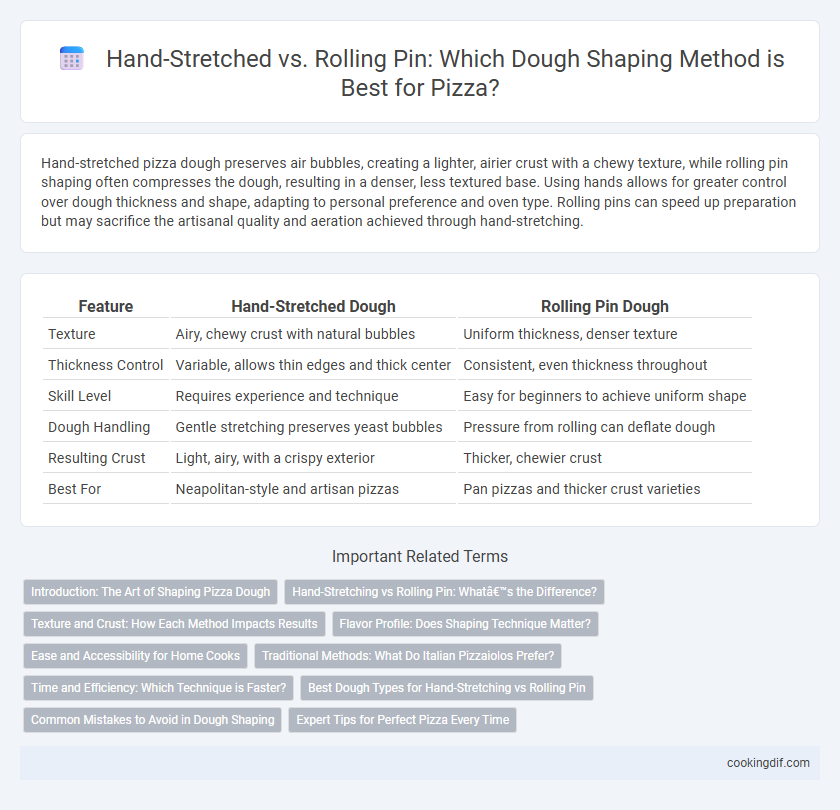Hand-stretched pizza dough preserves air bubbles, creating a lighter, airier crust with a chewy texture, while rolling pin shaping often compresses the dough, resulting in a denser, less textured base. Using hands allows for greater control over dough thickness and shape, adapting to personal preference and oven type. Rolling pins can speed up preparation but may sacrifice the artisanal quality and aeration achieved through hand-stretching.
Table of Comparison
| Feature | Hand-Stretched Dough | Rolling Pin Dough |
|---|---|---|
| Texture | Airy, chewy crust with natural bubbles | Uniform thickness, denser texture |
| Thickness Control | Variable, allows thin edges and thick center | Consistent, even thickness throughout |
| Skill Level | Requires experience and technique | Easy for beginners to achieve uniform shape |
| Dough Handling | Gentle stretching preserves yeast bubbles | Pressure from rolling can deflate dough |
| Resulting Crust | Light, airy, with a crispy exterior | Thicker, chewier crust |
| Best For | Neapolitan-style and artisan pizzas | Pan pizzas and thicker crust varieties |
Introduction: The Art of Shaping Pizza Dough
Hand-stretched pizza dough retains more air bubbles, creating a light, airy crust with a chewy texture prized in traditional Neapolitan pizzas. Using a rolling pin compresses the dough, resulting in a denser, uniform crust favored for thin-crust styles like New York pizza. Choosing between hand-stretched and rolling pin techniques significantly influences the final texture and flavor profile of the pizza.
Hand-Stretching vs Rolling Pin: What’s the Difference?
Hand-stretching pizza dough preserves its airy texture by gently pulling and rotating, which maintains gas bubbles essential for a light crust. Using a rolling pin compresses the dough, often flattening those bubbles and resulting in a denser, less chewy base. Artisanal pizzerias favor hand-stretching to achieve an authentic Neapolitan-style crust, while rolling pins offer convenience for uniform thickness in home baking.
Texture and Crust: How Each Method Impacts Results
Hand-stretched pizza dough creates a more airy, uneven texture with a chewier crust due to the gentle, uneven pressure that preserves gas bubbles. Rolling pin use yields a uniformly thin crust with a denser, less textured bite as the dough is compressed evenly, often reducing air pockets. Texture and crust crispiness vary significantly: hand-stretched dough promotes a crisp outer edge with a soft interior, while rolling pin dough tends to be consistently firm throughout.
Flavor Profile: Does Shaping Technique Matter?
Hand-stretched pizza dough develops a more complex flavor profile due to gentle handling that preserves air bubbles, resulting in a lighter, ferment-enhanced crust. Using a rolling pin compresses the dough, reducing fermentation impact and yielding a denser texture with less pronounced flavor nuances. Flavor intensity and crust texture vary significantly between hand-stretched and rolling pin techniques, emphasizing the importance of shaping method in artisan pizza quality.
Ease and Accessibility for Home Cooks
Hand-stretched pizza dough offers greater ease and accessibility for home cooks by allowing more control over thickness and texture without needing specialized tools. Rolling pins require less skill but may compress the dough, leading to a denser crust instead of the desired airy texture. Most home cooks find hand-stretching more intuitive, especially when aiming for an authentic pizzeria-style pizza crust.
Traditional Methods: What Do Italian Pizzaiolos Prefer?
Italian pizzaiolos traditionally favor hand-stretched dough shaping for its ability to preserve the dough's air bubbles, resulting in a lighter, more elastic crust with optimal texture. This method relies on skillful manual stretching and spinning, which maintains gluten structure without overworking the dough compared to rolling pins that can compress and toughen the base. Hand-stretching aligns with artisanal pizza-making practices, emphasizing control over thickness and preserving dough integrity for authentic Neapolitan-style pizzas.
Time and Efficiency: Which Technique is Faster?
Hand-stretched pizza dough allows for quicker shaping by using finger pressure to gradually expand the dough, reducing preparation time compared to rolling pins that require precise, repetitive rolling motions to achieve uniform thickness. Rolling pins can be efficient for consistent dough thickness but often take longer to shape large quantities, making hand-stretching a preferred method in fast-paced pizzerias. The choice impacts overall kitchen workflow, with hand-stretching yielding faster dough handling and increased efficiency in time-sensitive environments.
Best Dough Types for Hand-Stretching vs Rolling Pin
Hand-stretching is ideal for high-hydration doughs like Neapolitan and artisan-style pizzas, as it preserves air bubbles and ensures a light, airy crust. Doughs with lower hydration and higher gluten content, such as those used for thin-crust or cracker-style pizzas, respond well to rolling pins, creating a uniformly thin and crisp base. Selecting hand-stretching or rolling pin methods depends on the dough's hydration, gluten development, and desired crust texture for optimal pizza results.
Common Mistakes to Avoid in Dough Shaping
Hand-stretched dough often leads to uneven thickness and tearing if too much force is applied or if the dough is not rested properly. Rolling pins can result in overly dense crusts by pressing out air bubbles essential for a light, airy texture. Avoiding excessive pressure and allowing the dough to relax are key steps to achieve an ideal pizza crust regardless of the shaping method.
Expert Tips for Perfect Pizza Every Time
Hand-stretched pizza dough retains more air bubbles, creating a lighter, airier crust preferred by expert pizzaiolos who value texture and flavor complexity. Using a rolling pin ensures uniform thickness, ideal for consistent cooking and crispiness, often favored in high-volume kitchens. Master chefs recommend gently hand-stretching dough to preserve gluten structure while avoiding excessive thinning, resulting in the perfect balance of chewy and crisp crust.
Hand-stretched vs Rolling pin for dough shaping Infographic

 cookingdif.com
cookingdif.com